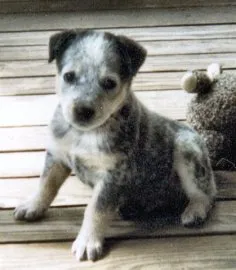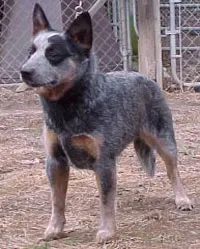For many dog enthusiasts, the term “Blue Heeler” conjures images of intelligent, robust, and uniquely mottled working dogs. They are undeniably popular, known for their striking appearance and energetic personalities. However, beneath the widely recognized nickname lies a common point of confusion: Is a “Blue Heeler” the same as an Australian Cattle Dog (ACD)? Or are they two distinct types of canines? If you’ve ever asked “Show Me Pictures Of Blue Heelers” and found a bewildering array of dogs, you’re not alone. This article aims to clarify this fascinating distinction, offering a visual guide and in-depth information to help you understand these remarkable dogs.
What Exactly is a “Blue Heeler”? (And Why It’s Complicated)
The term “Blue Heeler” is widely used, particularly in the United States, to describe dogs with blue-mottled or speckled coats that resemble Australian Cattle Dogs. However, it’s crucial to understand that “Heeler” (in this informal sense) is not a formally recognized breed by major kennel clubs like the American Kennel Club (AKC) or the Australian National Kennel Council (ANKC). This lack of formal recognition leads to significant variability within dogs simply called “Heelers.”
Unlike recognized breeds that adhere to strict standards, dogs referred to as “Heelers” can exhibit a wide range of sizes, shapes, and even temperaments. For instance, observations suggest regional differences: a “Texas-bred Heeler” might be anywhere from 30 to 50 pounds, sometimes displaying neurotic or overly obsessive tendencies due to non-selective breeding practices. In contrast, “South Dakota bred Heelers” might be larger, often resembling an ACD on steroids, potentially calmer and more intelligent. While their blue or red mottle coloring is generally consistent, you might occasionally spot tri-colored or even piebald variations. This broad spectrum often makes it challenging to predict the specific traits of an informally bred “Heeler.”
The Australian Cattle Dog (ACD): A Recognized Standard
In stark contrast to the informal “Heeler,” the Australian Cattle Dog (ACD) is a well-established, formally recognized breed with a rich history and specific breed standards. Developed in Australia in the 19th century to herd cattle over vast distances in harsh terrain, ACDs are known for their exceptional intelligence, stamina, and loyalty. They are often referred to as “Queensland Heelers” or simply “Blue Heelers” (or “Red Heelers” for red-mottled coats) within the context of their breed, which adds to the common confusion.
According to breed standards, ACDs are sturdy, compact, and muscular dogs. They possess a distinctive head with broad skull, strong muzzle, and pricked ears set wide apart. Their bodies are slightly longer than they are tall, with deep chests and strong, muscular legs. ACDs typically carry a brush-like tail that reaches to the hock. Their coats come in blue (blue, blue-mottled, or blue speckled, with or without black, tan, or white markings) or red (red-mottled or red speckled, with or without darker red markings). These dogs are renowned for their keen minds, protective instincts, and need for substantial mental and physical stimulation, making them ideal companions for active owners.
Visual Differences: “Heelers” vs. ACDs in Pictures
When you ask to “show me pictures of blue heelers,” you’ll often see dogs that fall into both categories: the formally recognized Australian Cattle Dog and the more broadly defined “Heeler.” While many “Heelers” strongly resemble ACDs, subtle yet noticeable differences can often be observed in their physical characteristics, especially in the head, body proportions, and tail carriage. The images below offer a visual comparison, highlighting the diversity within “Heelers” and the adherence to standards in ACDs.
“Heeler” Pictures: The Diverse Look
These images showcase dogs commonly referred to as “Heelers,” demonstrating the range of appearances possible outside of strict breed standards. Notice the variations in head shape, ear set, and overall build.
 A blue heeler dog with a white chest, standing alertly, showing a broader head shape than a typical ACD and ears set slightly lower.
A blue heeler dog with a white chest, standing alertly, showing a broader head shape than a typical ACD and ears set slightly lower.
Australian Cattle Dog Pictures: Adhering to the Standard
These images represent Australian Cattle Dogs, showcasing the consistent physical traits and breed type recognized by official kennel clubs. Observe the characteristic head shape, ear placement, and body structure.
 An Australian Cattle Dog with intense focus, showcasing the breed's powerful neck and sturdy frame, designed for strenuous herding work, and a proportionally correct head.
An Australian Cattle Dog with intense focus, showcasing the breed's powerful neck and sturdy frame, designed for strenuous herding work, and a proportionally correct head.
Generally, “Heelers” can have heads that appear slightly different, with ears set further down than the characteristic high-set ears of an ACD. Australian Cattle Dogs tend to be slightly longer in body, with a specific body depth-to-leg-length ratio. While ACDs often retain full-length tails, many “Heelers” found in informal breeding lines might have docked tails, though this practice varies regionally and by individual breeder choice.
Are “Heelers” Simply Unregistered or Mixed-Breed ACDs?
The question of whether “Heelers” are one and the same as Australian Cattle Dogs often boils down to breeding practices. Many dogs informally called “Heelers” are indeed descendants of Australian Cattle Dogs, but they have been bred without adhering to official breed standards. This non-selective breeding, or “backyard breeding,” can lead to a divergence in appearance and temperament from the recognized ACD standard. Some “Heelers” may also be mixed with other breeds, such as Border Collies, as mentioned in the original query, which further contributes to their varied characteristics.
The consequence of such breeding can range from unpredictable size and appearance to potential genetic health issues and temperament challenges. A well-bred Australian Cattle Dog from a reputable breeder will have predictable traits due to generations of selective breeding for health, temperament, and adherence to the breed standard. In contrast, an informally bred “Heeler” might be a wonderful companion, but their specific characteristics can be more of a “genetic lottery.” This highlights the importance of responsible breeding to maintain the health and integrity of any dog population.
Conclusion
Understanding the distinction between a “Blue Heeler” and an Australian Cattle Dog can be complex, primarily due to the informal use of the “Heeler” moniker. While many dogs referred to as “Blue Heelers” share common ancestry and physical traits with the Australian Cattle Dog, only the ACD is a formally recognized breed with established standards for appearance and temperament. The visual examples above demonstrate the consistency of the ACD breed standard versus the more varied characteristics seen in general “Heelers.” Whether you’re interested in a purebred Australian Cattle Dog or an equally charming “Heeler” type, thorough research into their background and the breeder’s practices is essential. This will ensure you find a healthy, well-adjusted dog whose traits align with your lifestyle.
For more information on dog breeds and responsible pet care, explore other articles on Dog Care Story.
References
- American Kennel Club (AKC). (n.d.). Australian Cattle Dog. Retrieved from [internal_links]
- Australian National Kennel Council (ANKC). (n.d.). Breed Standard: Australian Cattle Dog. Retrieved from [internal_links]
- Dog Breed Health Association. (n.d.). Understanding Responsible Dog Breeding. Retrieved from
